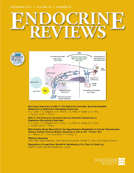-
Views
-
Cite
Cite
Charmian A. Quigley, Alessandra de Bellis, Keith B. Marschke, Mostafa K. El-Awady, Elizabeth M. Wilson, Frank S. French, Androgen Receptor Defects: Historical, Clinical, and Molecular Perspectives, Endocrine Reviews, Volume 16, Issue 3, 1 June 1995, Pages 271–321, https://doi.org/10.1210/edrv-16-3-271
Close - Share Icon Share
IN 1953 lohn Morris, an obstetrician at Yale University, reported a series of 82 individuals (80 cases collated from the literature and two cases of his own) who had a female phenotype despite the presence of bilateral testes (1). Since his initial description, studies of the endocrinology, pathophysiology, biochemistry, and molecular biology of the androgen insensitivity syndrome (AIS) have provided insights into the role of androgens in male sex differentiation, the mechanisms of androgen action, and aspects of the structure/function relationships of the androgen receptor. AIS is an archetypal example of a hormone resistance disorder. Androgens are secreted by the testes of these 46,XY individuals in normal or increased amounts; however, due to defective androgen receptor (AR1) function, there is loss of target organ response to the hormone, and the effects of androgens are reduced or absent. Clinical disorders of the AR are reported far more commonly than resistance disorders of other members of the steroid receptor family and, in fact, more mutations have been reported in the AR gene than in that of any other transcription factor (2). This is, in part, due to the fact that the AR is encoded by a single copy X-chromosomal gene (it is the only X-chromosomal steroid receptor gene).





